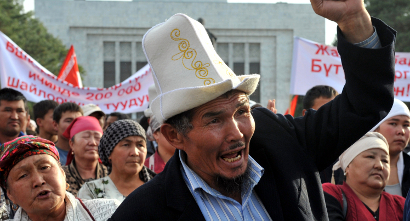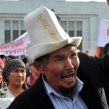
A New Wave of Protests in Kyrgyzstan
Publication: Eurasia Daily Monitor Volume: 9 Issue: 182
By:

On October 3, the Kyrgyz opposition tried to capture the parliament building, where the office of the president and his administration are also located. The rally resulted in shooting by the police and subsequent dispersal of the protesters. The gathering was organized by leaders of the opposition party Ata Zhurt and parliament members Sadir Zhaparov and Kamchibek Tashiyev. About 500 demonstrators demanded the immediate nationalization of the Kumtor gold mine, without interruption of its operations. Although at first the rally was peaceful, it took an unexpected turn after the speech of Kamchibek Tashiyev. A crowd of young people ran to the parliament building and tried to enter its premises. Employees of the State Security service— police, cavalry and officers with dogs—prevented their attempt. The police fired shots. They then used stun grenades against the protesters, who were dispersed in several minutes. At least a dozen people, including six police officers, suffered injuries (Akipress.kg, Ferghannews.com, October 3, Kommersant, October 4).
In the evening, Kamchibek Tashiyev, Sadyr Zhaparov and another member of parliament, Talant Mamitov, were detained for 48 hours at a State Committee of National Security detention facility on suspicion of trying to seize power ( Akipress.kg, October 3).
On October 4, about 1,000 supporters of the detained lawmakers blocked the highway Osh–Bishkek in the southern Jalalabad province, the homeland of Kamchibek Tashiyev and Talant Mamitov. They demanded the release of the detained lawmakers. The Tyan Shan mountain range divides southern and northern Kyrgyzstan and the Osh–Bishkek highway is the only road linking South with North. About one hundred supporters of the deputies also gathered near the State Committee of National Security in Bishkek (Akipress.kg, October 4).
Kumtor, the second largest gold mining operation in the world, is owned by the Canadian mining company, Centerra Gold, but Kyrgyzstan has 33% stocks in the company. Observers like Daniil Kislov, director of the Ferghana News agency, believe that Kumtor was just a pretext for the violent action in front of parliament. Two weeks ago, Kyrgyzstan’s Prosecutor General made a submission to the parliament about removing Sadir Zhaparov’s parliamentary privileges: he was accused of seizing property belonging to the family of Kyrgyzstan’s ex-president Kurmanbek Bakiyev during the uprising in April 2010. Experts believe that Zhaparov is now trying to deflect attention from this criminal case (Ferghananews.com, October 4).
This version has been implicitly confirmed by a report from K-News. The news agency’s correspondent talked with protestors who claimed that Zhaparov was not involved in capturing the Bakiyev family’s property (Kyrgyzstan information agency K-News, October 3).
The latest events in Kyrgyzstan are unusual in their pattern. Almost every rally in the country results in clashes with the police, but except for the “revolutions” in 2005 and 2010, demonstrators have not tried to attack the parliament. After the first “Tulip” revolution in 2005, political protests in the republic have been allegedly connected with the organized crime network jockeying for power. Most participants in rallies are unemployed young people, who are reportedly paid by the organizers. According to Bishkek human right defender Toktaim Umatalieva, a participant of a rally “earns” $10-15 (DW-WORLD.DE, February 17, 2011).
It also appears that rally participants are not aware of the purpose of their gatherings and other relevant facts related to the protests. According to the news agency Ferghana, participants in the October 4 rally in Bishkek did not know why the authorities detained the parliamentarians. People, who gathered in front of parliament on October 3, could not explain how Kumtor’s nationalization would help Kyrgyzstan (Ferghananews.com, October 3, Ferghana October 4).
It should be noted that Ata-Zhurt opposition party has a virulently nationalist platform. At the rally on October 3, Sadir Zhaparov publicly stated that Kumtor “belongs to the Jews” (K-News, October 3). During the parliamentary elections in 2010, Kamchibek Tashiyev said that the Kyrgyz should have more rights than other ethnic groups in the state (Ferghananews.com, September 16, 2010).
After the armed conflict between ethnic Uzbeks and Kyrgyz in June 2010, ethnic clashes began to spread to the North of the republic. Such clashes are occurring between Kyrgyz and different ethnic (not only Uzbek) groups: Meskhetian Turks, Uyghurs, as well as Dagestanis. According to the ministry of internal affairs, there are 147 zones of potential ethnic conflict in Kyrgyzstan (Akipress.kg, January 26). During the second “revolution” of 2010, anti-Semitic signs were displayed for the first time in Kyrgyzstan. Bishkek’s synagogue was attacked, with assailants hurling Molotov cocktails at the one-story building and trying to set it aflame. In April 2010, an anti-Semitic banner was unfurled near the presidential palace at the central gathering area for protesters (jta.org, April 12, 2010).
“Unfortunately, after the 2010 revolution, nationalist sentiments started to be a very dangerous underlying factor in Kyrgyzstan, which the government needs to work on. The tragedy in Osh proved how devastating ethnic confrontations could be in Central Asia. In many ways, today’s Kyrgyzstan represents both the best and the worst of developments in the region,” according to Ivar Dale, Central Asia Regional Representative of the Norwegian Helsinki Committee (author’s interview, October 4).
The future of the conflict between the authorities and Ata Zhurt party depends on how the situation in southern Kyrgyzstan will develop. The problem of tribalism is acute in the state. Ata-Zhurt gets most of its support in the South. “If thousands and tens of thousands go out onto the streets of Jalal-Abad and Osh (the main towns in southern Kyrgyzstan), then the central authorities will have to come to an arrangement with Tashiyev. But if only a small number of the jailed parliamentarians’ relatives and paid comrades come out to the square, then these “revolutionaries” will not receive any leniency from the authorities,” wrote Daniil Kislov (Ferghananew.com, October 4). However, according to Alexander Knyazev, an Almaty-based coordinator of the Central Asia and Caucasus program at the Russian Institute of Oriental Studies, Kamchibek Tashiyev tries to unite all southern clans in the struggle with the North, thus, new protest actions are expected (Vesti.kg, October 4).




